|
IAFoL - it.arti.fumetti on line
The SANDMAN, Master of Dreams Introduzione a Death: Gaiman, Amos, Peyer Alcune piccole chicche prima di lasciarvi a tre brevi introduzioni, sempre relativamente a Death.
Il seguente dialogo è stato preso dal blog ufficiale di Gaiman. Il disegnatore Chris Bachalo si esprime riguardo a Death in quesi termini: "Death è un bel personaggio perché è saggia, e credo sia per questo motivo che molte persone sono attratte da lei. Inoltre è felice. È il personaggio più conosciuto nell'universo Vertigo perché è felice. Molti altri personaggi nella universo Vertigo tendono ad essere pessimisti. Sono anti eroi. Death non lo è. È sicuramente dark, si veste in nero, ha una pelle chiara, resta un po' nell'ombra, ma resta sempre felice, saggia e conosce molte cose. Non ci sono grandi alti e bassi nella sua personalità, e come disse una volta lo stesso Gaiman, è un personaggio difficile da scrivere, perché in definitiva non ha conflitti. E se non ci sono conflitti, non c'è neanche una storia, o perlomeno una interessante da raccontare. Ecco perché credo che le storie di Death non parlino di lei stessa." Buona lettura! In fondo alla pagina riporto un breve estratto di una intervista rilasciata a Roger A. Ash da Gaiman. Introduction to the Death Gallery by Neil Gaiman
He had arrived brooding, quiet, pale and gaunt and while there was indeed a definate family resemblance, she was in many ways his opposite: sensible, delightful, nice. Mike Dringenberg was at that time the inker of SANDMAN (Sam Keith was pencilling). He read my description of Death in the original SANDMAN outline and decided that she should look less like a young Nico or Louise Brooks (as I had suggested) and more like his friend Cinnamon. Mike did a drawing of her - the same drawing that appeared as a pinup in SANDMAN, and later as a T-shirt and a watch face. The day the drawing arrived in England, I had to meet Dave McKean at a London pancake house: he was to show me transparencies of the first few SANDMAN covers. Our waitress was Death: skinny and pale and elfin and sweet, with long dark hair and black clothes, and a silver ankh. I nearly showed her Mike's drawing, but then decided not to. There's a tale in the Caballa that suggests that the Angel of Death is so beautiful that on finally seeing it (or him, or her) you fall in love so hard, so fast, that your soul is pulled out through your eyes. I like that story. There's an Islamic story that declares that the Angel of Death has huge wings covered in eyes, and that as each mortal dies one of its eyes closes, just for a moment. I like that story too, and take pleasure in imagining huge wings, and a ripple of ever-opening, ever-closing beautiful eyes. And there's a touch of wish fulfillment in there too. I didn't want a Death who agonised over her role, or who took a grim delight in her job, or who didn't care. I wanted a Death that I'd like to meet, in the end. Someone who would care. Like her. -Neil Gaiman Introduction to Death: The High Cost of Living by Tori Amos It's funny but on good days I don't think of her so much. In fact never. I never just say hi when the sun is on my tongue and my belly's all warm. On bad days I talk to Death constantly, not about suicide because honestly that's not dramatic enough. Most of us love the stage and suicide is definately your last performance and being addicted to the stage, suicide was never an option - plus people get to look you over and stare at your fatty bits and you can't cross your legs to give that flattering thigh angle and that's depressing. So we talk. She says things that no one else seems to come up with, like let's have a hotdog and then it's like nothing's impossible. 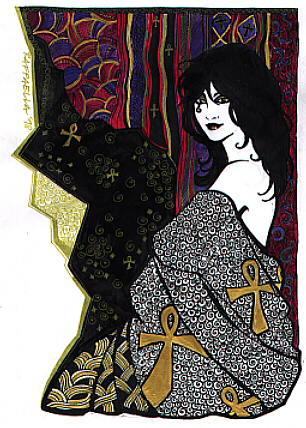
She told me once there is a part of her in everyone, though Neil believes I'm more Delirium thatn Tori, and Death taught me to accept that, you know, wear your butterflies with pride. And when I do accept that, I know Death is somewhere inside of me. She was the kind of girl all girls wanted to be, I believe, because of her acceptance of "what is". She keeps reminding me there is change in the "what is" but change cannot be made till you accept the "what is". Like yesterday, all the recording machings were breaking down again. We almost lost a master take and the band leaves tomorrow and we can't do anymore music till we resolve this. We're in the middle of nowhere in the desert and my being wants to go crawl under a cactus and wish it away. Instead, I dyed my hair and she visited me and I started to accept the mess I'm in. I know that mess spelled backwards is ssem and I felt much better armed with that information. Over the last few hours I've allowed myself to feel defeated, and just like she said if you allow yourself to feel the way you really feel, maybe you won't be afraid of that feeling anymore. When you're on your knees you're closer to the ground. Things seem nearer somehow. If all I can say is I'm not in this swamp, I'm not in this swamp then there is not a rope in front of me and there is not an alligator behind me and there is not a girl sitting at the edge eating a hot dog and if I believe that, then dying would be the only answer because then Death couldn't come and say Peachy to me anymore and after all she has a brother who believes in hope. -Tori Amos A Brief History of Death by Tom Peyer The woman you've just met isn't called Death just because of the tuff-sounding name complements her heavy eye makeup and black jeans. She really is Death, the reaper, the one who takes you away when you've had it. It turns out that cloak and the scythe and the skeleton are just bad press; there's nothing grim about her at all. Discriminating readers have known this since 1989, when she first appeared in her younger brother Dream's monthly comic book, THE SANDMAN. The title had already been making waves as an intelligent, involving adult fantasy series when writer Neil Gaiman and artists Mike Dringenberg and Malcolm Jones III twisted reader expectations by casting dream-weaver Morpheus as the grim, pale, gaunt one and Death as his cheerful foil. The two are members of the Endless, a loose-knit family of seven who embody their respective realms of Dream, Desire, Despair, Destiny, Delirium, Destruction, and Death. Roughly as old as time, they are not merely gods or patron saints; they are the things themselves, personified. That initial story, "The Sound of Her Wings," first printed in SANDMAN #8, went something like this: feeding pigeons in the park, Dream broods after recovering his domain in the wake of a major setback. His problems had given him a sense of purpose; now that they're largely solved, that sense is gone. Death quotes Mary Poppins - Death quotes Mary Poppins! - and draws her brother's feelings out before angrily refusing to indulge his self-pity. Permitting him to tag along as she casually and graciously collects the dead, she cheers him up by sheer example: if she can find satisfaction in her everyday routine, so can he. Generously displaying her Sunday school sweetness and her rock-club looks over what amounted to 24 pages of sibling interaction (an unusually quite theme for comics, to say the least), "The Sound of Her Wings" instantly made Death even more popular than the book's title character. Still one of the best-received Sandman stories to date, you can find it in not one but two paperback collections: SANDMAN: THE DOLL'S HOUSE and SANDMAN: PRELUDES & NOCTURNES.
Death next appeared in SANDMAN #20, in "Facade," the tragic story of a woman trapped by life, by Gaiman and artists Colleen Doran and Malcolm Jones III. Urania Blackwell wants to kill herself, but a magical artifact of the Egyptian god Ra transformed her into the super-hero Element Girl, and no one can kill Element Girl. When danger threatens, she transmutes into an appropriately defensive element... voluntarily or not. When Death claims her neighbor, Urania begs to be taken, but Death cannot oblige. She does, however, take pity on Element Girl, and helps Urania find her owne solution. "Facade" is available in SANDMAN: DREAM COUNTRY. By now, we've seen Death's devotion to her work, her refusal to take it too seriously, her flippant humor, and, again surprisingly, a hint of a social worker's bleeding heart. Her next appearances, collected in SANDMAN: SEASON OF MISTS, display her willingness to stand against her brother when he is wrong (#21, by Neil Gaiman and Dringenberg) and an unexpectedly flexible approach to her job when circumstances warrant. The latter is apparent in SANDMAN #25, as Gaiman and Jones are accompanied by penciller Matt Wagner. hell has given up its dead, and a harried, aerobics-outfitted Death has her hands full restoring the proper balance. We see her attempting to collect 13-year-old Charles Rowland and simply giving up when he refuses to come along, preferring to see what life has to offer with his fellow dead boy Edwin Paine. In SANDMAN SPECIAL #1, by Gaiman and Bryan Talbot, Death exempts another: Dream's son, the Orpheus of myth, who wishes to enter the realm of the dead unscathed to rescue his beloved Eurydice. As an unintented result of her boon, Orpheus survives his own beheading by centuries. This and SANDMAN #31, in which Gaiman and artist Shawn McManus introduce us to Death's favorite king, can be found in SANDMAN: FABLES AND REFLECTIONS. Nearly every SANDMAN collection contains an appearance by Death, and she continues to appear frequently in his ongoing monthly title (most recently #53). Her popularity has given her a life beyond Sandman stories, chiefly with the material on view here. The original publication of DEATH: THE HIGH COST OF LIVING helped launch DC's VERTIGO line of comics for mature readers with a remarkable critical and commerical response. "Death Talks About Life" ran as an insert in the several pre-VERTIGO titles and met with a tide of interest in its message, causing it to be rereleased as a public service pamphlet. The point being: after you've read this book and you find yourself smiling when you think about Death, there's more about her out there. -Tom Peyer
|
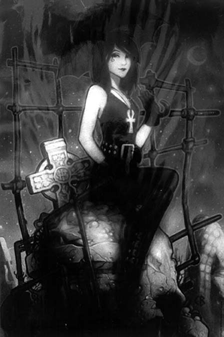 Gaiman racconta altri particolari in merito a questo meraviglioso personaggio: “Death è l'unico protagonista principale il cui modello visuale non è stato pensato da me. Il merito è di Mike Dringenberg. Nella mia bozza originale di Sandman avevo suggerito un look come quello della cantante Nico nella foto del 1968 dell'album Chelsea Girl, con quelle guance e quel viso così perfetto. Ma Mike aveva le sue idee e mi mandò un disegno basato su una donna che conosceva chiamata Cinnamon. Lo guardai ed ebbi una immediata reazione di sorpresa e piacere. Lo stesso giorno andai a cena con Dave McKean e la cameriera che ci servì fu una sorta di visione. Era americana, aveva lunghi capelli neri, era vestita interamente in nero e aveva una grande ankh d'argento attorno al collo. E aveva lo sguardo proprio come l'aveva disegnato Mike. Ogni volta che veniva al nostro tavolo a servirci e poi andava via sussurravo a Dave: “dobbiamo farle vedere il disegno?” E Dave continuava a rispondere “Oh no, è troppo imbarazzante.” Così non lo facemmo. Ma considerai questa casualità come un segno del destino.
Gaiman racconta altri particolari in merito a questo meraviglioso personaggio: “Death è l'unico protagonista principale il cui modello visuale non è stato pensato da me. Il merito è di Mike Dringenberg. Nella mia bozza originale di Sandman avevo suggerito un look come quello della cantante Nico nella foto del 1968 dell'album Chelsea Girl, con quelle guance e quel viso così perfetto. Ma Mike aveva le sue idee e mi mandò un disegno basato su una donna che conosceva chiamata Cinnamon. Lo guardai ed ebbi una immediata reazione di sorpresa e piacere. Lo stesso giorno andai a cena con Dave McKean e la cameriera che ci servì fu una sorta di visione. Era americana, aveva lunghi capelli neri, era vestita interamente in nero e aveva una grande ankh d'argento attorno al collo. E aveva lo sguardo proprio come l'aveva disegnato Mike. Ogni volta che veniva al nostro tavolo a servirci e poi andava via sussurravo a Dave: “dobbiamo farle vedere il disegno?” E Dave continuava a rispondere “Oh no, è troppo imbarazzante.” Così non lo facemmo. Ma considerai questa casualità come un segno del destino.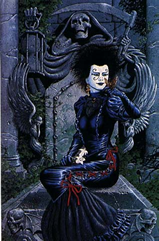 I've told, many times, the weirdness of that day. The drawing arrived in the morning. I took it up to the Society of Strip illustration meeting that evening, when I was meeting Dave McKean to talk about Sandman covers. We went down to the My Old Dutch Pancake House, and were served by this astoundingly beautiful, skinny, long-dark-haired, American girl with an ankh on, who looked exactly like Mike Dringenberg's drawing. I mean not looked sort of like Mike Dringenberg's drawing, but looked like it to the point where I kept saying to Dave McKean, "Shall I show her?" [Laughs.] She was the kind of person that you meet, and you sort of..."fall in love with" are the wrong words, "have a crush on" are the wrong words...but are immediately just sort of besotted with. Dave and I would just sort of stare at her as she walked around the room [laughs] in that sort of pleasurable state of going, "Oh, she's wonderful..." Had she come up to us afterwards and said, "Now, I need you two to come with me and make war," we would have said, "Oh, okay. So it's off to war!" I kept saying to Dave, "Should I show her the drawing?" And he kept saying, "No, it's embarrassing. Shut up." So I didn't. In the morning, when the drawing had arrived, I wasn't certain. I looked at it and went, "Well, I think he's got it. I think this is really cool." By the end of that evening, I said, "Oh, yeah. That's Death. I know what she sounds like [laughs], I know how she moves, I know what it's like sitting there while she brings you a pancake. Great. I'm in there." I think that was part of that lovely sensibility.
I've told, many times, the weirdness of that day. The drawing arrived in the morning. I took it up to the Society of Strip illustration meeting that evening, when I was meeting Dave McKean to talk about Sandman covers. We went down to the My Old Dutch Pancake House, and were served by this astoundingly beautiful, skinny, long-dark-haired, American girl with an ankh on, who looked exactly like Mike Dringenberg's drawing. I mean not looked sort of like Mike Dringenberg's drawing, but looked like it to the point where I kept saying to Dave McKean, "Shall I show her?" [Laughs.] She was the kind of person that you meet, and you sort of..."fall in love with" are the wrong words, "have a crush on" are the wrong words...but are immediately just sort of besotted with. Dave and I would just sort of stare at her as she walked around the room [laughs] in that sort of pleasurable state of going, "Oh, she's wonderful..." Had she come up to us afterwards and said, "Now, I need you two to come with me and make war," we would have said, "Oh, okay. So it's off to war!" I kept saying to Dave, "Should I show her the drawing?" And he kept saying, "No, it's embarrassing. Shut up." So I didn't. In the morning, when the drawing had arrived, I wasn't certain. I looked at it and went, "Well, I think he's got it. I think this is really cool." By the end of that evening, I said, "Oh, yeah. That's Death. I know what she sounds like [laughs], I know how she moves, I know what it's like sitting there while she brings you a pancake. Great. I'm in there." I think that was part of that lovely sensibility.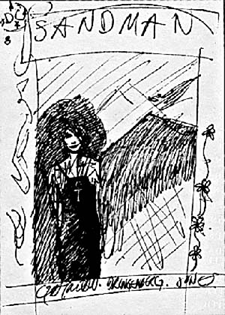 She arrived in my head about a week after her brother.
She arrived in my head about a week after her brother.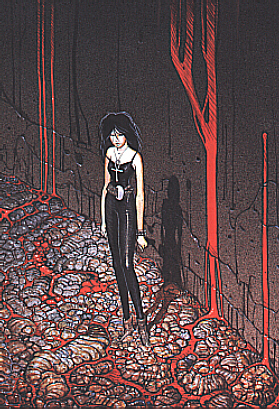 Fans demanding to see Death again had to wait a mere four months for SANDMAN #12's "Men of Good Fortune," by Gaiman and artists Michael Zulli and Steve Parkhouse. Here we learned that Death doesn't always take her job completely seriously. Observing tavern life in the 14th-century London, she and Dream take special notice of Hob Gadling, a soldier who boasts that his stubborn refusal to die will keep him alive forever. Amused by his impertinence, Death grants him immortality. Over the ensing centuries, Dream strikes ups a fond friendship with this mortal who can't die. Again, Death's light heart enriches what might otherwise be a bleak existence for her brother. "Men of Good Fortune" can be found in the collected SANDMAN: THE DOLL'S HOUSE.
Fans demanding to see Death again had to wait a mere four months for SANDMAN #12's "Men of Good Fortune," by Gaiman and artists Michael Zulli and Steve Parkhouse. Here we learned that Death doesn't always take her job completely seriously. Observing tavern life in the 14th-century London, she and Dream take special notice of Hob Gadling, a soldier who boasts that his stubborn refusal to die will keep him alive forever. Amused by his impertinence, Death grants him immortality. Over the ensing centuries, Dream strikes ups a fond friendship with this mortal who can't die. Again, Death's light heart enriches what might otherwise be a bleak existence for her brother. "Men of Good Fortune" can be found in the collected SANDMAN: THE DOLL'S HOUSE.